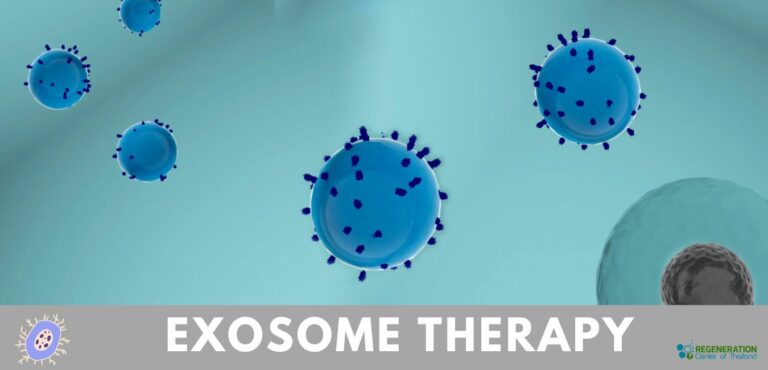
Exosomes are loosely described as extracellular vesicles of fluid first used in inter-cell communication ( paracrine signaling) and these fluid-filled structures are usually released by cells after fusion of multivesicular body (MVB) and the plasma membrane. This process helps release intraluminal vesicles (ILVs) into the extracellular membrane (milieu) and the release vesicles are what we refer to as exosomes.
These extracellular vesicles can also be used in stem cell therapies as a vehicle to take advantage of the beneficial cell signaling that occurs in the natural regeneration process to help control behavior of surrounding cells or to carry treatment doses in the bloodstream throughout the body including the ability to cross the blood-brain barrier [1] for promoting neurogenesis in treatments in neurodegenerative conditions, spinal cord injuries, strokes, brain injuries & bypass all other immune checkpoints in the body. The therapeutic potential in homing/migration of MSC cells and to hijack the neural stem cell messaging system via laboratory produced extracellular vesicles is especially powerful considering the same vesicles are also used by the body to spread disease, damaged proteins & genetic information for many conditions including Dementia, Parkinson’s disease along with metabolic disorders like obesity & diabetes.
Cancer cell-derived exosomes is another promising field with the goal of using exosomes to deliver vaccines or drugs in cancer immunotherapies, lung cancer treatments, prostate cancer treatment & treatment for pancreatic cancers. [2] These manufactured cancer exosome markers are able to send antigens to dendritic cells when then induces a T-cell-mediated response to surrounding cancer cells.
By enhancing the beneficial signals given out by stem cells scientist are able to manipulate exosomes behavior to solve medication delivery problems for many types of therapies including:
Doctors are hoping these isolate and purified exosomes vesicles (for immunoregulation) could one day become a new sector in regenerative medicine and stem cell treatments where MSC-derived exosomes are already being used for its healing properties in patients with COPD and pulmonary fibrosis lung disease. [3]
There are several natural sources of extracting exosome including immature dendritic cells (imDCs). Learn more about dendritic cells in our glossary or FAQ sections. The exosomes that are secreted by dendritic cells lack surface markers resulting in very low risk for an immune response (immunogenicity.)[4] Exosomes can also be produced from CD34+ stem cells that are isolated from peripheral blood, amniotic membrane, cord tissue ( Wharton’s jelly), bone marrow, adipose fat, and dental pulp.
Exosomes are small extracellular vesicles (30-150 nm in size) released by cells into their environment. They play essential roles in cell-to-cell communication by transferring various molecules between cells, such as proteins, lipids, and nucleic acids.
When exosomes reach an acceptor cell, the following processes may occur:
Overall, the interaction between exosomes and acceptor cells is a very complex and regulated process that plays a critical role in various pathological & physiological conditions, such as immune responses, tissue repair, and cancer progression.
To learn more about Exosomes uses in functional medicine or genetic testing services please contact us.
[1] ^ Chen, Claire C, Linan Liu, Fengxia Ma, Chi W Wong, Xuning E Guo, Jenu V Chacko, Henry P Farhoodi, et al. 2016. Elucidation of Exosome Migration across the Blood-Brain Barrier Model In Vitro. Cellular and molecular bioengineering, no. 4 (July 7). doi:10.1007/s12195-016-0458-3. https://www.ncbi.nlm.nih.gov/pubmed/28392840
[2] ^ Chen, Wen, Mingcan Yang, Jian Bai, Xiang Li, Xiangrui Kong, Yu Gao, Lili Bi, Li Xiao, and Bingyi Shi. 2017. Exosome-Modified Tissue Engineered Blood Vessel for Endothelial Progenitor Cell Capture and Targeted siRNA Delivery. Macromolecular bioscience, no. 2 (December 4). doi:10.1002/mabi.201700242. https://www.ncbi.nlm.nih.gov/pubmed/29205878
[3] ^ Sung, Bong Hwan, and Alissa M Weaver. 2017. Exosome secretion promotes chemotaxis of cancer cells. Cell adhesion & migration, no. 2 (January 27). doi:10.1080/19336918.2016.1273307. https://www.ncbi.nlm.nih.gov/pubmed/28129015
[4] ^ Urbanelli, Lorena, Sandra Buratta, Krizia Sagini, Giuseppina Ferrara, Marco Lanni, and Carla Emiliani. 2015. Exosome-based strategies for Diagnosis and Therapy. Recent patents on CNS drug discovery, no. 1. https://www.ncbi.nlm.nih.gov/pubmed/26133463
Chimeric antigen receptor-T cell treatment (CAR-T cell therapy) holds immense potential to revolutionize organ transplantation, particularly for patients who struggle… Read More
In the ever-evolving landscape of nutrition science, the discourse around dietary fats has undergone significant transformation. The Regeneration Center is… Read More
New research shows that specific types of brain cells become active after brain injuries and exhibit properties similar to those… Read More
Chemokines, critical components in the immune system, are small proteins that facilitate the migration and positioning of immune cells throughout… Read More
Stem cell research examines everything from gene expression to differentiation capacities to therapeutic potentials. With such diverse data types and… Read More
Stem cell therapy has emerged as a revolutionary new treatment approach for neurological and spinal disorders. One up-and-coming method of… Read More